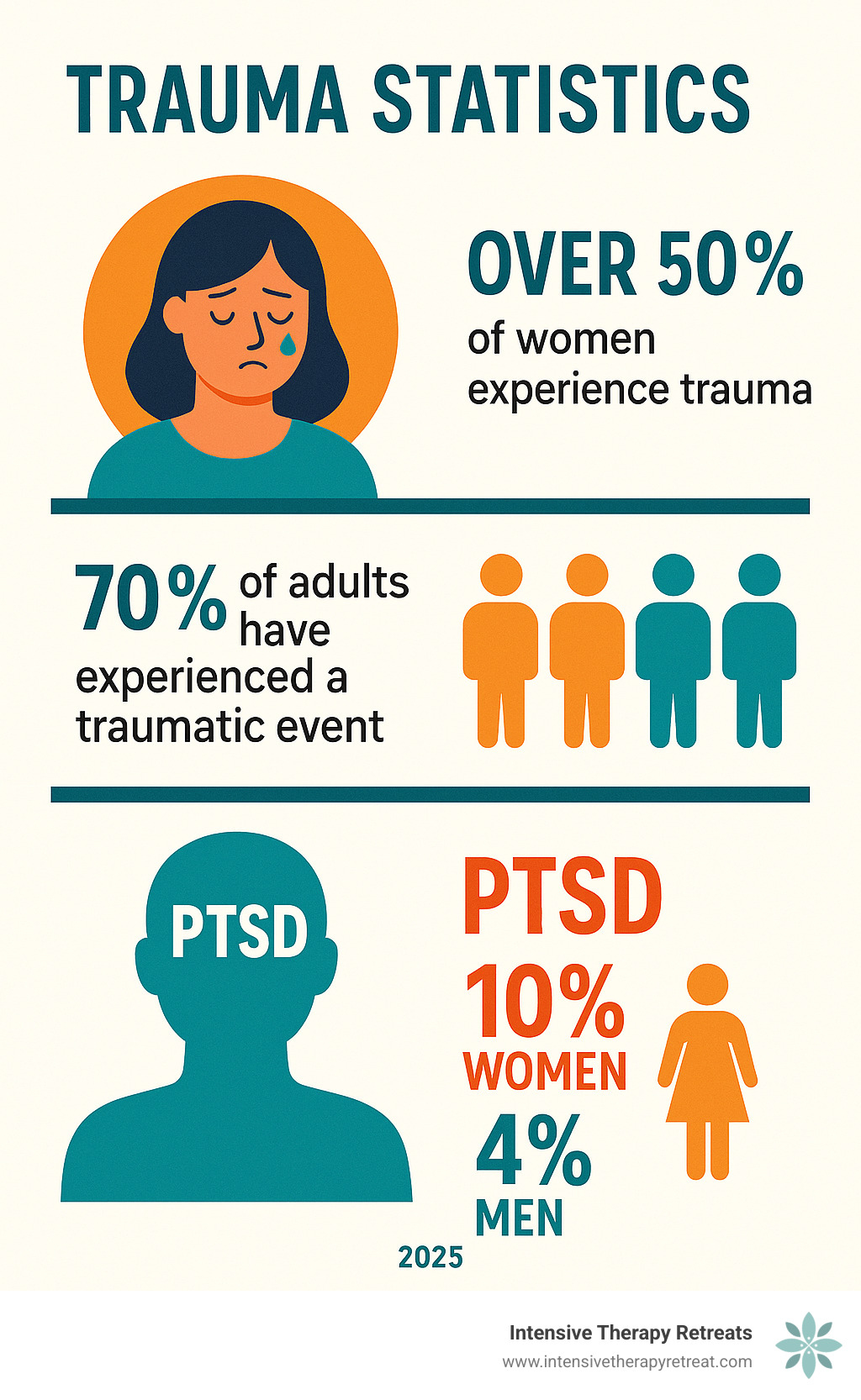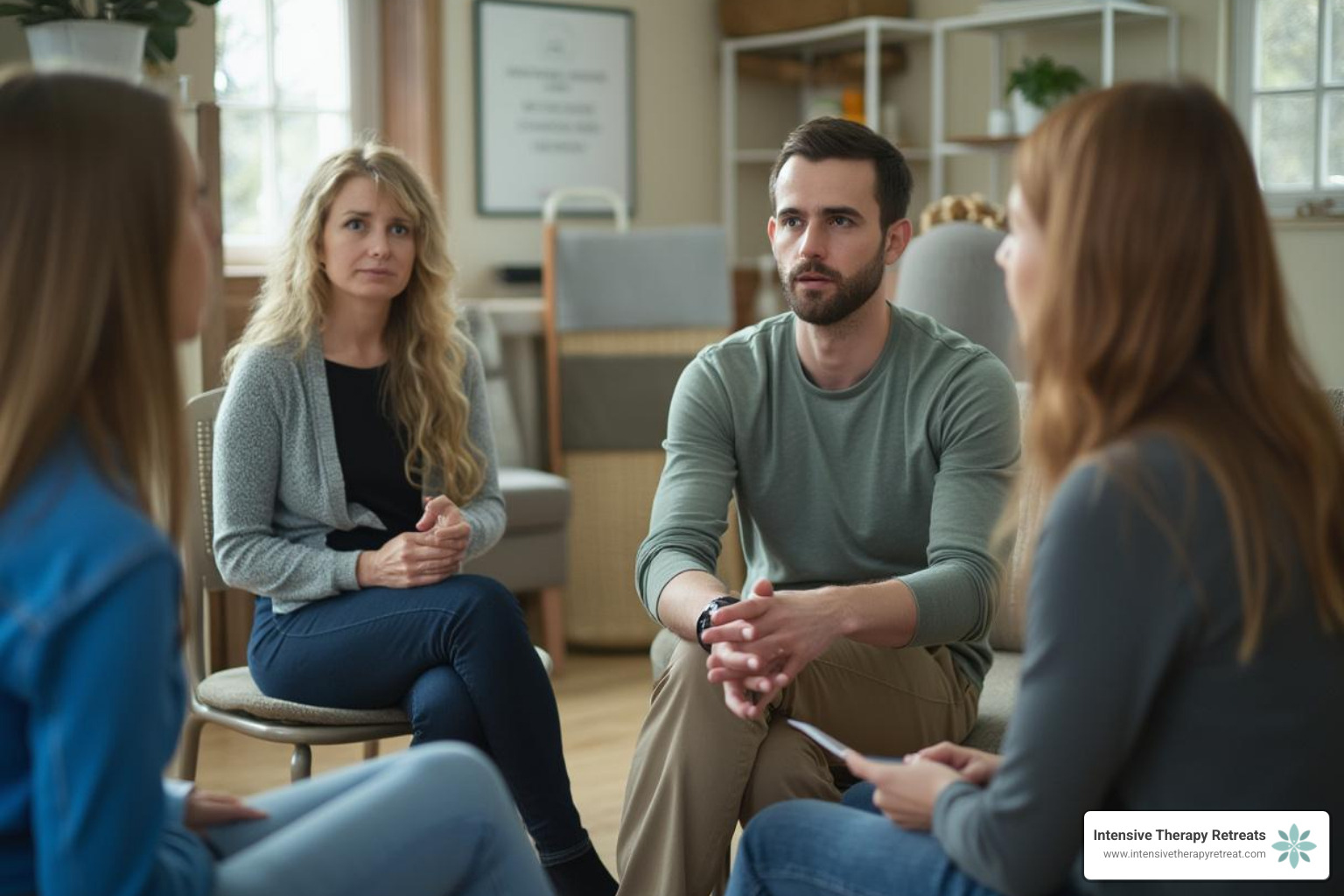Why Group Therapy Offers a Powerful Path to Trauma Recovery
When trauma strikes, it often leaves us feeling utterly alone. The statistics, however, tell a different story: more than half of all women will face at least one traumatic event in their lifetime, and about 10% of all women will develop PTSD compared to about 4% of men. You are far from alone in this struggle.
Group therapy breaks through this isolation by connecting you with others who truly understand. Research shows that the shared experience of group healing can be just as effective as individual therapy, offering unique benefits like reduced shame, normalized responses, and the powerful realization that recovery is possible.
A typical sample of sessions for trauma group therapy follows a structured, three-phase approach designed to guide participants from isolation to healing:
- Phase 1: Building Safety. Establishing trust, learning about trauma responses, and developing grounding techniques.
- Phase 2: Processing and Skill-Building. Sharing experiences (if you choose), challenging negative thoughts, and developing emotional regulation skills.
- Phase 3: Integration and Moving Forward. Focusing on post-traumatic growth and creating a personalized wellness plan for the future.
As Bambi Rattner, Psy.D., I’ve spent over three decades helping trauma survivors heal. I’ve witnessed how a thoughtfully structured group can transform lives. Let me guide you through what this journey looks like and how it can become your roadmap to recovery.
Simple guide to sample of sessions for trauma group therapy terms:
- trauma therapy session overview
- explanation of 2 person trauma focused therapy session ptsd
- questions for trauma focused therapy session ptsd
Understanding the Foundations of Trauma Group Therapy
Trauma group therapy provides a safe, nurturing space to process experiences, gain insights, and develop coping strategies alongside others who understand. The primary goals are to foster safety, reduce the profound sense of isolation that trauma often creates, build essential life skills, and normalize your reactions.
Trauma is a deeply personal response to an overwhelming event that can leave you feeling disconnected from yourself and the world. In a group setting, we work to reverse this by helping you reconnect with yourself and a supportive community. While individual therapy offers a deep dive into your personal story, group therapy harnesses the power of shared healing. It’s where you find that “the best part about being with a group is that you don’t have to do everything alone.” Hearing the words, “me too,” is a powerful antidote to the shame and self-blame that often linger after trauma.
The Unique Benefits of a Group Setting
What makes a group setting so uniquely powerful for healing from trauma? It’s a special combination of human connection and therapeutic principles.
- Universality: Realizing you’re not alone in your struggles is incredibly validating.
- Altruism: The act of supporting others can be empowering and healing in itself.
- Instillation of Hope: Seeing others progress on their healing journey provides powerful motivation.
- Imparting Information: You’ll learn about trauma responses and coping strategies from both the therapist and other group members.
- Corrective Recapitulation: The group provides a safe space to understand and heal from past relationship patterns.
- Development of Socializing Techniques: It’s a low-pressure environment to practice communication, build trust, and develop healthier relationship skills.
- Interpersonal Learning: You gain a deeper understanding of your own patterns and how you relate to others.
- Group Cohesiveness: A strong sense of belonging and acceptance creates a powerful foundation for healing.
This rich environment is why a sample of sessions for trauma group therapy can be so transformative.
Types of Trauma Groups and Approaches
Different types of trauma groups are designed to meet various needs.
- Psychoeducational Groups: Focus on teaching you about trauma and its effects on your brain, body, and emotions. You’ll learn about common responses and strategies for managing symptoms.
- Skills-Based Groups: Often using principles from Cognitive Behavioral Therapy (CBT) and Dialectical Behavior Therapy (DBT), these groups teach practical tools for emotion regulation, distress tolerance, and interpersonal effectiveness.
- Process-Oriented Groups: Emphasize the “here and now” interactions among members, allowing for deep emotional processing and corrective relational experiences.
- Support Groups: Provide a peer-led environment for sharing experiences and offering mutual encouragement and validation.
Many groups use evidence-based techniques, such as Trauma-Focused Cognitive Behavioral Therapy (TF-CBT) principles, to help participants challenge unhelpful thought patterns. They may also integrate mindfulness, somatic work, or creative expression to create a holistic healing experience.
Understanding the Foundations of Trauma Group Therapy
At its core, trauma group therapy is designed to provide a safe, supportive environment where individuals can process their experiences, gain insights, and develop coping strategies together. The primary goals are to foster safety, reduce the profound sense of isolation that trauma often creates, build essential coping skills, and normalize the wide range of emotional and physical responses to distressing events.
Trauma is a deeply personal and often overwhelming experience, a subjective response that can overwhelm our ability to cope. It can lead to a disconnection from our thoughts, emotions, and surroundings, sometimes resulting in dissociative symptoms. In a group setting, we work to reverse this by creating an environment where individuals can reconnect not just with themselves, but with a community that understands.
This type of therapy differs significantly from individual therapy in its emphasis on shared experience and peer support. While individual therapy offers a deep dive into personal history and specific processing, group therapy leverages the power of collective healing. It’s a place where we learn that “the best part about being with a group is that you don’t have to do everything alone,” and that “some of the most comforting words in the universe are ‘me too.’” This universality is a powerful antidote to shame and self-blame, which are common after trauma.
A Sample of Sessions for Trauma Group Therapy: The Phased Approach
Think of trauma recovery like building a house—you need a solid foundation before you can put up the walls and roof. A sample of sessions for trauma group therapy follows this same wisdom, using a structured three-phase approach that creates a predictable and safe journey toward healing. Most groups span 10-12 sessions, allowing for intentional, step-by-step progress.
Phase 1: Building Safety and Connection (Sessions 1-3)
These initial sessions are about laying the cornerstone for your healing. The primary focus is creating a space where you feel secure enough to begin the work.
- Establishing Trust: The group agrees on essential norms, with confidentiality as the golden rule. This ensures what’s shared in the group stays in the group.
- Psychoeducation: You’ll learn about how trauma affects the brain and body. Understanding that your reactions are normal responses to abnormal events can be incredibly validating. Scientific research on psychoeducation shows this knowledge alone can reduce symptoms.
- Grounding Techniques: You’ll learn practical, in-the-moment tools to calm your nervous system, such as the 5-4-3-2-1 exercise, mindful breathing, and progressive muscle relaxation.
Phase 2: The Heart of the Work – Processing and Skill-Building (Sessions 4-9)
With a foundation of safety established, the group moves into the core work of healing.
- Challenging Negative Thoughts: You’ll learn to identify and reframe the Automatic Negative Thoughts (ANTs) that trauma can create, such as self-blame or a sense of being broken.
- Regulating Emotions: Through techniques like expressive arts therapy, you’ll find ways to feel and process difficult emotions without becoming overwhelmed.
- Trauma Narrative Work: This is a gentle process focused on the themes and impacts of your experiences, not on reliving graphic details. Sharing is always optional and is done in a way that maintains safety for everyone, a key part of an effective approach to healing.
- Improving Relationships: You’ll practice interpersonal skills like setting healthy boundaries and communicating your needs, often using role-playing to build confidence.
Phase 3: Integration and Moving Forward (Sessions 10-12)
The final phase is about integrating your healing and preparing for the future with confidence.
- Focusing on Post-Traumatic Growth: The conversation shifts from what was lost to what has been gained—resilience, strength, and new perspectives. Activities often focus on recognizing and celebrating this growth.
- Creating a Wellness Plan: You’ll develop a personalized plan with self-care practices, coping strategies, and relapse prevention techniques to support your long-term well-being.
- Closure and Future Goals: The group reflects on the journey, acknowledges the progress made, and sets future-oriented goals. This phase ends with meaningful closure, marking a transition to the next chapter of your life.
Key Ingredients for a Successful Group Experience
Creating a successful trauma group therapy experience requires more than just a good plan. The magic happens when the right elements combine to create a truly healing environment.
- The Role of the Facilitator: A skilled therapist is crucial. They act as both guide and guardian, creating a safe container for difficult emotions and adapting to the group’s needs.
- Participant Screening: Not everyone is ready for group work at the same time. Careful screening ensures that members are at a stage where they can both give and receive support effectively.
- A Safe and Supportive Environment: This is the non-negotiable foundation. It involves establishing clear boundaries, maintaining consistent expectations, and ensuring that every member feels seen, heard, and respected. A safe and supportive environment is built on both physical and emotional safety.
Navigating Challenges and Group Dynamics
Even in the best groups, challenges arise. How they are handled is key to the group’s success.
- Addressing Conflict: A skilled facilitator helps the group steer disagreements constructively, turning potential ruptures into opportunities for growth.
- Managing Triggers: Members are taught to recognize their own triggers and use coping tools. The facilitator helps manage these moments to maintain group safety.
- Vicarious Trauma: The group openly discusses the emotional impact of hearing others’ stories and learns strategies for self-protection and self-care.
- Attendance and Boundaries: Consistency is vital for building trust. The group upholds norms around attendance, punctuality, and confidentiality to maintain a predictable and secure space.
- Handling Setbacks: Healing is not linear. The group learns to support members through difficult weeks, reinforcing the message that setbacks are a normal part of the process.
The Role of Social Identity in a Sample of Sessions for Trauma Group Therapy
When people with shared experiences come together, it creates a powerful healing dynamic known as the “social cure.” Seeing your own struggles reflected in others helps dissolve the shame and isolation that trauma breeds.
For those who have experienced stigmatized trauma (e.g., sexual assault, combat), being in a group with others who have similar histories can be particularly powerful. It creates a space where certain fears and experiences don’t need to be explained—they are simply understood. A culturally sensitive facilitator honors the diverse backgrounds of group members while helping them find common ground in their shared humanity.
The sample of sessions for trauma group therapy helps you build a new, empowered identity as a survivor. You come to see the strength and resilience in others and, in turn, recognize it in yourself.
Beyond the Sessions: Sustaining Your Healing Journey
Healing from trauma is a journey, not a destination. While a sample of sessions for trauma group therapy provides a powerful foundation, sustaining your progress means weaving the skills you’ve learned into your daily life. This involves ongoing self-care, self-awareness, and connection.
Key practices include regularly checking in with your emotional state, using journaling for integration, and practicing mindfulness and somatic exercises to calm your nervous system and reconnect with your body. It’s also vital to continue building a strong support network outside of therapy with trusted friends, family, and community resources.
At-Home Activities to Complement Your Therapy
To reinforce what you’ve learned, try incorporating these simple, empowering activities into your routine:
- Mindful Walking: Pay attention to your senses and the rhythm of your breath as you walk.
- Creative Expression: Use art, music, or writing as a non-verbal outlet for your emotions.
- Body Scan Meditations: Gently bring awareness to different parts of your body to release tension.
- Gratitude Journaling: Note things you’re grateful for each day to shift your focus toward the positive.
- Connecting with Nature: Spend time outdoors to feel grounded and restored.
- Progressive Muscle Relaxation: Tense and then release muscle groups to reduce physical tension.
- Self-Compassion Exercises: Practice treating yourself with the same kindness you would offer a friend.
- Physical Exercise: Move your body regularly to manage stress and boost your mood.
- Engaging in Relaxing Hobbies: Make time for activities that bring you joy and a sense of normalcy.
A Look at a Sample of Sessions for Trauma Group Therapy and Long-Term Recovery
Long-term recovery is about consistently applying the tools you’ve gained. This means maintaining your self-care practices, recognizing your triggers, and knowing when to lean on your support systems. It’s not about forgetting the past, but about integrating your experience in a way that allows you to live a full, meaningful life.
Many people find post-traumatic growth—a deeper appreciation for life, stronger relationships, and a new sense of personal strength. Life after trauma is not defined by what happened to you, but by the resilience and wisdom you’ve cultivated on your healing journey.
Frequently Asked Questions about Trauma Group Therapy
It’s natural to have questions before starting group therapy. Here are answers to some of the most common concerns about a sample of sessions for trauma group therapy.
What if I’m too scared to share my story in a group?
This is a very common and valid fear. A well-facilitated group never forces anyone to share. Your primary role is to feel safe, and you can learn and heal simply by listening and being present. The group moves at a pace that respects everyone’s comfort, and you always have the right to “pass” on sharing. Often, hearing others’ stories and realizing you’re not alone is a powerful first step.
How is confidentiality maintained in a group setting?
Confidentiality is the bedrock of group therapy. In the first session, all members agree to a strict confidentiality policy: what is said in the group stays in the group. The facilitator reinforces this rule throughout the process to build a culture of trust. While therapists are legally and ethically bound to confidentiality, the group’s safety relies on the shared commitment of all members. This mutual understanding of vulnerability creates a strong, protective bond.
Is group therapy enough, or should I also be in individual therapy?
This depends on your individual needs. Group and individual therapy offer different but complementary benefits. Individual therapy provides a private space for deep, personalized work. Group therapy offers the unique power of shared experience, which reduces isolation and normalizes your feelings.
Many people find that combining both is the most effective approach. Individual therapy can help you build the skills needed to feel comfortable in a group, while the group provides a space to practice those skills with peer support. Your treatment team can help you determine the best level of care for you based on factors like the signs and symptoms of PTSD.
For those seeking rapid and profound healing, our intensive therapy retreats combine the best of both worlds, offering focused individual work alongside powerful group connection. This immersive approach can help you achieve in days what might take months in traditional therapy.
Conclusion
Trauma can be an incredibly isolating experience, but group therapy shows you that you are not walking this path alone. The journey through a structured program—from building safety to processing experiences and integrating new skills—provides a clear roadmap to recovery.
The power of shared experience helps dissolve shame and builds a community of hope and resilience. In a group, you witness the courage of others and, in turn, find your own. The coping skills you learn become lifelong tools, and the connections you forge can provide lasting support.
Recovery isn’t about erasing the past, but about integrating it to build a stronger, more meaningful future. This is the essence of post-traumatic growth. The skills and connections you gain are yours to carry forward, long after the final session.
For those who feel ready to dive deeper into intensive healing work, our immersive therapy retreats offer a unique opportunity to accelerate your recovery journey. By combining proven methods like EMDR, Internal Family Systems, and Accelerated Resolution Therapy in a focused, supportive environment, we help you achieve in days what might otherwise take months or years. Learn more about our intensive trauma therapy retreats and find how concentrated healing can transform your life.
Healing is not just possible—it’s your birthright. Your story of recovery is waiting to be written.




